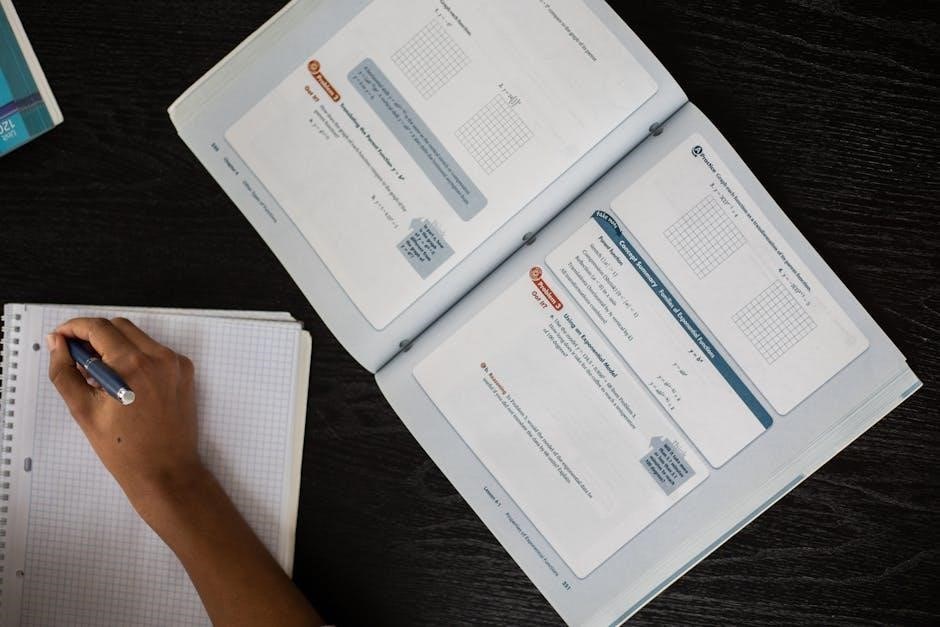
grade 7 math workbook pdf
This comprehensive Grade 7 math workbook is designed to help students master essential math skills through structured lessons and practice exercises. It covers key topics such as whole numbers, operations, fractions, and data handling, providing a solid foundation for academic success. The workbook is organized into clear chapters, each accompanied by practice worksheets, lesson tests, and an answer key to aid in self-assessment and improvement. Its engaging format and progressive difficulty ensure that students build confidence and proficiency in mathematics.
Overview of the Grade 7 Math Workbook
This Grade 7 math workbook is a comprehensive resource designed to support students in mastering essential mathematical concepts. Spanning 104 pages, it covers a wide range of topics, including whole numbers, place value, exponents, order of operations, fractions, decimals, percentages, and signed numbers. The workbook is structured to provide a clear progression of lessons, with each chapter accompanied by practice worksheets and assessments to reinforce learning. It also includes an answer key for self-assessment and improvement. Additional resources, such as extra practice worksheets and project activities, are available to cater to diverse learning needs. The workbook is organized to familiarize students with standardized test formats and improve their problem-solving strategies. It serves as an effective tool for both classroom and homeschool learning, ensuring a strong foundation in mathematics.
Importance of Using a Workbook for Learning
Using a Grade 7 math workbook is essential for building a strong foundation in mathematics. It provides structured practice, reinforcing concepts learned in class and helping students develop problem-solving skills. The workbook’s organized format ensures that students can work independently, with clear examples and exercises that cater to various learning styles. Immediate feedback through answer keys allows students to identify and correct mistakes, fostering self-assessment and confidence. Regular use of the workbook helps improve time management and study habits, which are critical for academic success. Additionally, the workbook’s inclusion of test preparation materials familiarizes students with standardized test formats, reducing anxiety and enhancing performance. By consistently practicing with the workbook, students can master math concepts and develop a lifelong love for learning.
Structure and Organization of the Workbook
The Grade 7 math workbook is meticulously organized to ensure a logical progression of learning. It is divided into clear chapters, each focusing on specific math topics such as whole numbers, fractions, and data handling. Within each chapter, practice worksheets, lesson tests, and assessments are included to reinforce understanding. The workbook also features an answer key, enabling students to verify their work and identify areas for improvement. Standardized test preparation materials are integrated to familiarize students with test formats, reducing exam anxiety. Additional resources, such as extra practice worksheets and project activities, are provided to enhance engagement and deepen comprehension. This structured approach ensures that students can systematically build their math skills and confidence throughout the year.

Core Math Concepts Covered
This workbook covers essential math topics, including whole numbers, place value, exponents, fractions, decimals, percentages, signed numbers, mean, median, mode, range, and data handling, providing a comprehensive foundation.
Whole Numbers and Place Value
The workbook begins with a strong foundation in whole numbers and place value, essential for building math proficiency. Students learn to read, write, and compare whole numbers up to millions, Understanding place value concepts like ones, tens, hundreds, and thousands. Practice problems focus on adding, subtracting, multiplying, and dividing whole numbers, as well as rounding to the nearest ten or hundred. Real-world applications, such as calculating total costs or distances, help reinforce these skills. The lessons also introduce the concept of squares and higher powers, with exercises to identify perfect squares and their roots. Clear examples and step-by-step solutions guide students through each concept, ensuring they master whole numbers and place value before progressing to more complex topics.
Exponents and Order of Operations
The workbook dedicates a section to exponents and the order of operations, crucial for solving complex mathematical expressions. Students learn to evaluate expressions with exponents, understanding concepts like squared and cubed numbers. The order of operations—PEMDAS (Parentheses, Exponents, Multiplication and Division, Addition and Subtraction)—is thoroughly covered, with practice problems that emphasize its importance. Worksheets include mixed-operation problems, requiring students to apply these rules step-by-step. Real-world scenarios, such as calculating distances or budget planning, illustrate the practical use of these skills. The workbook provides clear examples and solutions, ensuring students grasp how to simplify expressions accurately. This section builds a strong foundation for algebra and higher-level math, helping students approach problems with confidence and precision.
Fractions, Decimals, and Percentages
This section of the workbook focuses on understanding and manipulating fractions, decimals, and percentages, essential skills for real-world applications. Students learn to convert between these forms, simplify fractions, and perform operations such as addition, subtraction, multiplication, and division. Practice problems include comparing and ordering fractions, finding equivalent fractions, and calculating percentages. Word problems, such as determining discounts or mixing ingredients, help apply these concepts practically. The workbook also includes visual aids like diagrams and charts to clarify complex relationships. With progressively challenging exercises, students build fluency in handling fractions, decimals, and percentages, preparing them for advanced math topics. The answer key provides feedback, ensuring students can identify and correct mistakes independently.
Signed Numbers and Integers
This section of the workbook introduces students to signed numbers and integers, focusing on their properties and operations. Lessons cover adding, subtracting, multiplying, and dividing positive and negative integers, along with understanding absolute values. Practice exercises include simplifying expressions with signed numbers and solving real-world problems, such as calculating temperature changes or financial transactions. The workbook provides clear examples and step-by-step solutions to help students grasp these concepts. Visual aids, such as number lines, are used to illustrate the addition and subtraction of integers. With progressively challenging problems, students develop proficiency in working with signed numbers and integers, building a strong foundation for algebra and higher-level math. The answer key allows for self-assessment and reinforces understanding.
Mean, Median, Mode, and Range
This section of the workbook focuses on teaching students how to calculate and interpret measures of central tendency and variability. Clear explanations and examples guide students in understanding mean, median, mode, and range. Practice problems involve analyzing datasets to find these measures, helping students grasp their practical applications. The workbook includes exercises on identifying modes in lists of numbers and calculating ranges from given data. Visual representations, such as bar graphs and box plots, are used to enhance understanding. Students also learn how to compare and interpret these measures in real-world contexts, such as test scores or weather data. The answer key provides feedback, ensuring students master these essential statistical concepts. This section builds a foundation for more advanced data analysis in higher grades.
Least Common Denominators (LCDs)
This section of the workbook introduces students to the concept of Least Common Denominators, essential for operations involving fractions. Detailed examples and step-by-step instructions guide students in identifying and calculating LCDs for sets of numbers. Practice problems range from finding LCDs for pairs of numbers to applying them in complex fraction operations. The workbook emphasizes real-world applications, such as combining ingredients in recipes or calculating distances. Visual aids and diagrams help students visualize the process, while exercises gradually increase in difficulty to build confidence. The included answer key allows for self-assessment, ensuring students grasp this fundamental skill before moving on to more advanced fraction problems. This section is crucial for mastering fraction arithmetic and prepares students for algebraic concepts.
Simple Equations and Algebra
This section focuses on introducing students to the basics of solving simple equations and understanding algebraic concepts. It begins with one-step and two-step equations, teaching students how to isolate variables using inverse operations. The workbook includes numerous practice problems, such as solving for unknowns in equations like ( x + 5 = 12 ) or ( 3y = 24 ). Word problems are also incorporated to apply these skills in real-world scenarios. Visual aids, such as balancing scales and algebra tiles, are used to help students visualize the concept of equality. The exercises progressively increase in difficulty, introducing variables on both sides of the equation and simple quadratic expressions. The answer key provides solutions to all problems, enabling students to verify their work and improve their algebraic reasoning skills. This section is foundational for higher-level math and critical thinking.
Lines and Angles

This section of the Grade 7 math workbook introduces students to the fundamental concepts of lines and angles, essential for geometry. It begins with identifying and classifying different types of lines, such as parallel, perpendicular, and intersecting lines, using diagrams and examples. The workbook progresses to angles, teaching students to recognize acute, obtuse, right, and straight angles, as well as how to measure them using protractors. Exercises include calculating the sum of angles around a point and understanding properties of angles formed by transversals and parallel lines; Practice problems involve drawing and labeling angles, solving for unknown measures, and applying these concepts to real-world scenarios. The section builds a strong foundation in geometry, preparing students for more complex topics in later grades. The answer key provides detailed solutions to ensure understanding and accuracy.
Data Handling and Probability
This section of the Grade 7 math workbook focuses on data handling and probability, helping students understand how to organize, interpret, and analyze data effectively. Lessons cover constructing and reading various types of graphs, including bar graphs, pie charts, and line graphs, to visualize data. Students learn to calculate averages, ranges, and modes, and how to interpret trends from data sets. The workbook also introduces basic probability concepts, such as determining the likelihood of events and understanding probability scales. Practice exercises include creating surveys, collecting data, and predicting outcomes based on probabilities. These activities encourage critical thinking and real-world applications of data handling and probability, preparing students for more advanced statistical analysis in higher grades. The answer key provides clear solutions to reinforce learning and accuracy.

Test Preparation and Practice
This workbook includes practice worksheets, lesson tests, and an answer key to help students prepare for standardized tests. It improves problem-solving skills and time management effectively.
Standardized Test Format Familiarization
The workbook helps students become familiar with the format and language of standardized tests, reducing anxiety and improving performance. It includes practice questions modeled after real tests, ensuring students understand question types, timing, and instructions. Specific sections focus on time management and strategies for tackling multiple-choice and open-response questions. By replicating the structure of actual exams, the workbook builds confidence and preparedness, allowing students to navigate test formats with ease. This feature is particularly beneficial for students who may be new to standardized testing or need additional support in test-taking skills. Regular exposure to test-like questions enhances their ability to approach exams calmly and effectively. This aspect of the workbook is designed to complement academic learning with practical test readiness.
Practice Worksheets for Each Lesson

The workbook includes practice worksheets for every lesson, ensuring students can apply what they’ve learned. Each worksheet is tailored to specific topics, such as whole numbers, fractions, and data handling, reinforcing key concepts. The exercises vary in difficulty, from basic drills to more complex problems, catering to diverse learning needs. By completing these worksheets, students develop fluency and confidence in their math skills. The structured format allows for systematic review and mastery of each lesson’s objectives. Regular practice helps students identify areas for improvement and solidify their understanding before moving on to more advanced topics. This targeted approach ensures that learning is both effective and enjoyable, making math more accessible and less intimidating for young learners.
Lesson Tests and Assessments
Lesson tests and assessments are integral to the workbook, providing opportunities for students to evaluate their understanding after each lesson. These tests cover a range of topics, from fractions and exponents to data handling and probability, ensuring comprehensive coverage of the curriculum. Each assessment includes multiple-choice questions, short-answer problems, and open-response items to cater to different learning styles. The tests are designed to track progress, identify strengths, and highlight areas needing improvement. Regular assessments help students develop a routine of reviewing and applying their knowledge. Additionally, they prepare students for the format and structure of standardized tests, building confidence and reducing exam anxiety. The workbook’s assessments are structured to promote consistent learning and long-term retention of math concepts.
Answer Key for Worksheets and Tests
The workbook includes a detailed answer key for all worksheets and tests, providing clear solutions and explanations for each problem. This resource enables students to self-assess their work, identify mistakes, and understand the correct methods for solving problems. The answer key is organized by chapter and lesson, making it easy to reference specific exercises. It not only helps students verify their answers but also serves as a learning tool by breaking down complex problems into step-by-step solutions. Teachers and parents can also use the answer key to guide students and provide additional support. By reviewing the answer key, students can reinforce their understanding and improve their math skills effectively. This feature ensures accountability and fosters a deeper grasp of the material.

Skills Development
The workbook enhances critical thinking and problem-solving skills through structured exercises, fostering mathematical reasoning and logical analysis. It promotes effective time management and study habits for academic success.
Building Critical Thinking Skills
The Grade 7 math workbook is designed to foster critical thinking through engaging exercises and real-world applications. By solving problems involving whole numbers, fractions, and data handling, students develop analytical abilities. The structured lessons encourage logical reasoning and methodical problem-solving. Practice worksheets and tests help students apply mathematical concepts to diverse scenarios, enhancing their capacity to think critically. The inclusion of word problems and multi-step exercises further challenges students to approach problems from different angles, improving their cognitive flexibility. This workbook equips students with the skills to break down complex problems into manageable parts, making it an invaluable tool for nurturing critical thinking in mathematics.
Improving Problem-Solving Strategies
The Grade 7 math workbook emphasizes the development of effective problem-solving strategies through a variety of exercises and real-world applications. Students learn to approach problems systematically, analyzing each step and applying appropriate mathematical concepts. The workbook includes word problems, multi-step equations, and data interpretation tasks that require logical thinking and precision. By practicing these exercises, students enhance their ability to identify patterns, break down complex problems, and arrive at accurate solutions. The structured format of the workbook, with clear explanations and examples, helps students build confidence in tackling challenges. Regular practice worksheets and tests further reinforce these skills, enabling students to develop a robust problem-solving mindset essential for academic success and beyond.
Enhancing Time Management for Tests
The Grade 7 math workbook incorporates timed practice tests and structured exercises to help students improve their time management skills during exams. By simulating real test conditions, these exercises enable students to become comfortable with pacing themselves and completing tasks within allocated time frames. The workbook provides tips on prioritizing questions, managing breaks, and minimizing errors under time pressure. Practice worksheets and lesson tests include answer keys, allowing students to assess their speed and accuracy. This focus on time management ensures students can apply their knowledge effectively during actual tests, reducing anxiety and improving overall performance. Regular practice helps build stamina and strategic thinking, equipping students with essential skills for standardized tests and beyond.
Developing Study Habits
The Grade 7 math workbook is designed to foster effective study habits by encouraging regular practice and structured learning. With organized chapters and clear instructions, students can easily follow a routine, breaking down complex topics into manageable tasks. The inclusion of practice worksheets and lesson tests helps students develop a consistent study schedule, ensuring they review and reinforce concepts regularly. The workbook also promotes self-assessment, allowing students to track their progress and identify areas for improvement. By creating a dedicated study environment and using the provided answer keys, students can cultivate discipline and responsibility in their academic pursuits. These habits not only enhance math skills but also contribute to overall academic success and lifelong learning.

Additional Resources
Supplement your learning with free online PDF resources, educational websites, and community learning opportunities. These tools offer extra practice, interactive lessons, and collaborative study environments to enhance math skills.

Online PDF Resources for Grade 7 Math
Free online PDF resources for Grade 7 math offer comprehensive lessons, practice problems, and interactive exercises. Websites like Cambridge Lower Secondary Mathematics and Spectrum provide downloadable workbooks covering topics such as whole numbers, fractions, and data handling. These resources are designed to supplement classroom learning, offering extra practice and test preparation materials. Many PDFs include answer keys and step-by-step solutions, enabling students to review and improve their math skills independently. Additionally, some resources focus on standardized test formats, familiarizing students with the structure and language of exams. These PDFs are easily accessible, making them a valuable tool for students seeking additional support or challenging material to advance their math proficiency.
Recommended Educational Websites
Several educational websites offer high-quality resources for Grade 7 math students. Khan Academy provides free video tutorials and practice exercises covering topics like fractions, exponents, and data handling. Coolmath and IXL offer interactive tools and worksheets tailored to middle school math curricula. Additionally, official websites for Cambridge Lower Secondary Mathematics and Spectrum Math provide downloadable materials and lesson guides. These platforms cater to diverse learning styles, offering a mix of visual, interactive, and printable resources. They are ideal for supplementing textbooks and workbooks, ensuring students can explore concepts in depth and reinforce their understanding through varied activities. Regular use of these websites can significantly enhance math proficiency and test preparedness.
Community and Peer Learning Opportunities
Engaging with peers and the community enhances math learning and fosters collaboration. Many schools organize math clubs or study groups where students can work together on problems from their workbooks. Online forums and educational platforms also provide spaces for students to discuss challenges and share solutions. Additionally, community centers often host math workshops or tutoring sessions, allowing students to learn from one another. Participating in these activities encourages teamwork, builds confidence, and helps students gain diverse perspectives on problem-solving. By leveraging these opportunities, Grade 7 students can create a supportive network that complements their workbook studies and enriches their overall learning experience.
Mastery of Grade 7 math requires consistent practice and dedication. This workbook provides the tools to build confidence, improve skills, and achieve long-term success in mathematics.
Final Tips for Mastering Grade 7 Math
To excel in Grade 7 math, prioritize regular practice and review. Use the workbook’s resources, such as practice worksheets and lesson tests, to reinforce understanding. Focus on mastering foundational concepts like fractions, exponents, and integers, as they form the basis for more complex topics. Break down problems into manageable steps to improve problem-solving skills. Utilize the answer key to identify and correct mistakes, ensuring a strong grasp of each lesson. Stay organized by keeping track of assignments and study schedules. Encourage a growth mindset by embracing challenges and seeking help when needed. Supplement learning with online resources and educational websites for additional practice. Consistent effort and dedication will lead to confidence and mastery in math.

The Role of Practice in Math Mastery
Consistent practice is essential for mastering Grade 7 math, as it reinforces understanding and builds problem-solving confidence. Regularly completing practice worksheets and lesson tests helps students apply concepts effectively. The workbook’s structured exercises allow learners to focus on specific skills, such as fractions, exponents, and order of operations, ensuring a strong foundation. Reviewing mistakes using the answer key fosters self-assessment and improvement. Practice also enhances speed and accuracy, crucial for test preparation. By dedicating time daily to work through problems, students can identify areas needing attention and gradually improve their math proficiency. Practice not only strengthens understanding but also instills a disciplined approach to learning, making it a cornerstone of math mastery.
Encouraging Continuous Learning
Continuous learning is vital for long-term math proficiency, and this Grade 7 workbook supports students in maintaining a steady pace of study. By incorporating extra practice worksheets, project activities, and access to online resources, the workbook motivates learners to explore math beyond classroom lessons. Regular engagement with the material helps students develop a routine and reinforces key concepts. The inclusion of supplementary resources, such as PDF guides and educational websites, further enriches the learning experience. Encouraging students to review and apply previously learned skills ensures a strong foundation for more complex topics. This structured approach fosters a mindset of ongoing improvement, helping students stay curious and committed to their math education.

Appendix
The appendix includes extra practice worksheets, project work, and activities to reinforce learning. These resources provide additional support for mastering math concepts and skills effectively.
Extra Practice Worksheets
The appendix provides a wealth of extra practice worksheets designed to reinforce key math concepts covered throughout the workbook. These additional exercises cover topics such as fractions, integers, and data handling, ensuring students have ample opportunities to practice and master their skills. The worksheets are organized by topic, allowing students to focus on specific areas where they need improvement. With a variety of problem types, including multiple-choice questions and open-ended problems, these resources cater to different learning styles. The inclusion of an answer key enables students to check their work and identify areas for further review. These worksheets are perfect for reinforcing learning, building confidence, and preparing for tests or exams. They serve as a valuable resource for both students and educators seeking additional practice material.
Project Work and Activities
The appendix includes a variety of engaging project work and activities designed to deepen students’ understanding of math concepts through hands-on learning. These projects encourage students to apply mathematical skills to real-world scenarios, fostering creativity and critical thinking. Activities such as data collection, graph creation, and problem-solving tasks are included, along with group projects that promote collaboration. For example, students might analyze and compare the hand span of Grade 7 boys and girls or explore the relationship between fractions and real-life measurements. These activities are aligned with the curriculum and provide opportunities for students to think innovatively while reinforcing key math principles. Detailed instructions and examples are provided to guide students through each project, making them both educational and enjoyable.